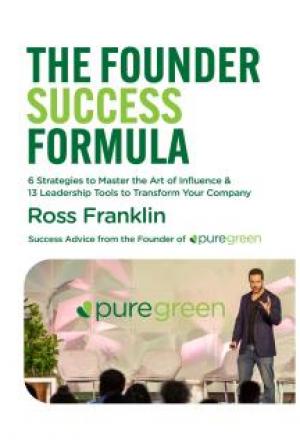The Art of
Influencing
Anyone
Make People Do Whatever You Want
Niall Cassidy
1
Copyright © 2008, 2013 by Niall Cassidy
Reprint Edition
All rights reserved. No part of this publication may be
reproduced, distributed, or transmitted in any form or
by any means, including photocopying, recording, or
other electronic or mechanical methods, without the
prior written permission of the publisher, except in the
case of brief quotations embodied in critical reviews
and certain other non-commercial uses permitted by
copyright law. For permission requests, write to the
publisher,
addressed
“Attention:
Permissions
Coordinator,” at the email address below.
Email: niallcassidy2013@gmail.com
Blog: niallcassidy.blogspot.com
ISBN: 978-988-12242-2-4
2
Table of Content
Part I: Introduction
Chapter 1: A Miracle at Kyle’s
5
Part II: Invincible Credibility
Chapter 2: Compelling Arguments
31
Chapter 3: Prophetic Predictions
58
Part III: Impeccable Marketing
Chapter 4: Instant Attention
88
Chapter 5: Covert Advertising
120
Part IV: Immaculate Conditioning
Chapter 6: Rapid Rapport
153
Chapter 7: Burning Desires
185
3
Part V: Conclusion
Chapter 8: Mrs. McKinsey Bought
219
4
1. A Miracle at Kyle’s
A Miracle in a Start-up Boutique
Mr. Kyle Thomson was a retired fashion designer. In an
attempt to avoid retirement boredom, he started a
small retail fashion shop called Kyle’s Boutique.
However, since it was his first time ever doing business,
he lacked the experience to manage his shop properly,
and thus it had been losing money every month since
its opening.
Needless to say, it was not a very encouraging
result, and Mr. Thomson was extremely disappointed.
However, just when he was about to give it up
altogether, a miracle suddenly happened in the shop.
One day, when Mr. Thomson checked his business
ledger, he was totally surprised. The sales had more
than doubled in just a few weeks. In addition to that, he
even found that some of the most expensive items,
which had never been sold, had disappeared from the
shelf as well.
5
Mr. Thomson was very perplexed. What had
happened? Had his shop caught the attention of a very
wealthy customer who liked his clothes a lot? Or had
someone written a very positive recommendation in a
local newspaper column? Or was it the eventual
success of his indefatigable comment-writing about his
shop on various websites and online forums?
Later, he found out that it was none of the above.
There were no particularly rich customers who had
stumbled upon his shop. No magazines or newspapers
had written about it. Nor was it related to all his
anonymous recommendations on the Internet. All these
were caused by an accident of hiring the right person.
Super Salesgirl
Scarlett was a university student who had just started
to work part-time in Mr. Thomson’s boutique. She had
never been employed as a full-time salesperson before,
nor ever participated in any related training courses.
When Mr. Thomson hired her, he thought she was just
another ordinary university girl who wanted to earn
some extra income while studying.
6
Despite that, just in the first month of work, she
had already sold much more things than anyone could
imagine. For every 10 transactions completed in the
shop, five or six of them would be contributed by
Scarlett. All the other people working in the shop were
stunned by her performance, and they all saw her as a
godsend for the business.
Of course, Mr. Thomson was delighted by Scarlett,
but at the same time, he was also extremely curious
about how she could achieve that, so he personally
invited her for coffee and a chat in a nearby café. After
they had settled down, Mr. Thomson told her:
“Scarlett, I am extremely grateful for your
contribution to my shop. As an encouragement to keep
up your good work, I will give you a bonus equal to 50
per cent of your salary this month, and I will raise your
salary permanently if you can maintain your amazing
feat.”
“I am very grateful,” said Scarlett, “It is very
important for me because I am from a very poor family.
It will be great if I can afford to live on my own without
spending a quid from my family.”
7
“I am glad that I can help,” said Mr. Thomson.
“Naturally, I am very curious how you could achieve
your result. Would you mind telling me more about the
secret of your success?”
“There is no secret at all,” laughed Scarlett, “It is
just that I am able to speak to the customers better
than other people in the shop.”
“And what do you mean by speaking better than
others?” asked Mr. Thomson.
“It means…”
“Scarlett!”
A voice behind them interrupted their
conversation.
A Horrible Customer
When Mr. Thomson looked back and tried to identify
the interrupter, he was surprised to find someone
whom he did not want to see.
8
The voice came from Mrs. McKinsey, a hideously
troublesome old widow. She was a very cagey and
stingy customer who always haggled whenever she
wanted to buy something, and always complained
about any imperfection she saw, no matter how trivial
it was. It was such a pain to do business with her that
there were a couple of times when Mr. Thomson was
tempted to tell her not to come back to his shop again.
Despite that, Mr. Thomson had to be polite, so he
greeted Mrs. McKinsey:
“Mrs. McKinsey, good afternoon! It's very fine
weather, isn’t it?”
“Indeed, Mr. Thomson,” said Mrs. McKinsey. “And
how is it going, Scarlett?”
“All going well,” said Scarlett. “Did your daughter
like the black blazer that you bought her last week?”
“Yes, she did!” said Mrs. McKinsey. “Thanks very
much for your suggestions. She liked it a lot!”
“Hold on a minute,” said Mr. Thomson. “Was it that
elegant slimfit jacket in black that went last week?”
9
“Exactly that one,” said Scarlett.
Mr. Thomson was perplexed. That jacket was one of
the most expensive items in his shop, but Mrs.
McKinsey only ever went after the cheapest ones. It
was breaking news indeed. Had she mutated into a
completely different person?
After Mrs. McKinsey went away, Mr. Thomson
asked Scarlett:
“How on earth did you manage to get her to buy
that blazer?”
“Well, she was actually very reluctant to buy
anything at first, but having talked to her a few times
before, I was able to understand what she liked most,
and I started working there.”
“How exactly did your conversation go?” asked Mr.
Thomson. He was very eager to know.
Scarlett began to recount exactly what had
happened on that day, and explained how she had got
the old woman to buy the blazer. Mr. Thomson realised
that the way she spoke to the customers was very
different from that of the other people.
10
It Is Good, So Do It.
People often feel helpless when they have to persuade
someone to do something. On one hand, we are all
social animals who cannot avoid interaction with other
people. No matter you are a salesman with a target to
meet, a parent trying to teach your kids to behave, or
a manager trying to improve your team’s performance,
you always want others to listen to you. It makes your
life easier.
However, many of us do not find it easy to get
people to listen to us. It is not all that unusual for your
customers to reject you, your kids to disobey you, or
people at work to ignore your ideas. At the same time,
perhaps you find it impossible to understand how a
particular person can manage to become a top
salesman, have kids who always behave, and get the
attention of everyone in the office whenever he has an
idea.
So why can some people become better persuaders
than most others? It certainly does not depend on their
having a higher level of intelligence than the rest of us –
11
in fact, it is more often the more “intelligent” people
who have trouble communicating with others, because
they may be prone to believing that others are too
stupid to understand them. Instead, what stands
between the good and bad persuaders is often the right
methods and techniques.
When most people try to persuade others, they
often follow a monotonic formula which is known as:
“It Is Good, So Do It.” For example, when an insurance
agent tries to persuade someone to buy a life insurance
policy from him, he usually says something like this:
“Insurance is not only a protection for yourself, but
also for your loved ones. I once had a client who bought
an insurance policy from me fifteen years ago. His
family consisted of a full-time housewife and three
little children. Five years ago, he was killed in an
accident. If he had not bought insurance, then not only
would his wife have been forced to work again, but his
children could also have been forced out of school.
Luckily, with the indemnity they were able to continue
to live comfortably.”
Basically, the agent is giving evidence that buying
insurance is useful, and his prospect is able to
12
understand the logic of what he is trying to illustrate.
However, to the prospect, it is just like watching a
tragic film in a cinema. He will probably think, “I can’t
argue against you, but I have been without any life
insurance for many years, and I am still fine. In addition,
I know that you are telling me this just because you
want to sell me insurance, so I will take it with a pinch
of salt.”
Even if you are not a salesman, you might
encounter a similar situation. For example, when a
father wants his son to study hard, he can tell him:
“Son, it is important to work hard and get good
grades. According to a latest survey by the BBC, those
who do not have a degree are paid at a level close to the
minimum wage. It means that you are going to end up
with a nasty job like your dad if you don’t work hard.”
In the above example, the father points out the
horrible consequences of not studying hard, supported
by the latest statistics – but do you think the son will
listen to him and start to work hard immediately?
Very unlikely that he will, because even though
what the father says is correct, the son will still find
13
excuses not to study. At first, he may in some way
appreciate that his father is right. However, after two
or three times, he will find his father very annoying,
and start to rationalise to himself: “There are many
successful people in the world, like Steve Jobs and Bill
Gates, who never got a university degree. Having a
degree does not mean everything.” Later, he may even
think: “Being rich does not mean everything. It is more
important to live happily when I am alive.”
In other words, we all like to convince others by
using logic, but logic alone is hardly enough to change
people. If it were, then there would not be millions of
people smoking every day, despite the proven hazards
of such a habit; or anyone risking his whole fortune on
the gambling table, despite the overwhelming odds
against his winning. Therefore, logical reasons should
never be the first things to pursue when trying to
persuade someone. So, what should you do instead to
persuade people?
14
Character over Content
In communication, there is a saying that what you say
is not as important as how you say it. While this is
certainly true, it is worth pointing out that how you say
it is still not as important as who says it. No matter who
you are speaking to, people often place more emphasis
on the identity of the speaker than the content of his
speech.
Here is a simple example. A doodle from a child is
regarded as a piece of cheap rubbish, but a similar
work from Picasso is considered a work of art, which
carries an astronomical price. To the untrained eye, the
two do not look very different, but if people know that
it is painted by a famous artist, then their perception
will change immediately, and they will think: “Oh, if it is
from Picasso, it must be good. If I fail to understand it,
it must be my problem.”
To further illustrate this point, let us revisit a
famous hoax in academia. For those who are not
familiar with this world, researchers often publish their
essays and reports in academic journals in order to
15
exchange findings and ideas. However, since there are
so many researchers from different universities and
institutions, a journal cannot possibly publish every
submission received. So how do the editors choose?
In principle, the editors select the most innovative
and insightful papers, but the number of submissions is
so overwhelming that they simply do not have time to
go through every one. So they use a simpler method:
they first look at those by the more famous and
renowned researchers – on the basis that if an author is
well regarded in the field, then his papers are unlikely
to be too bad.
This is where the aforementioned hoax comes in. In
1996, Professor Alan Sokal of New York University
submitted an article to an academic journal, Social Text.
The article was of very poor quality, and, as the author
put it, consisted of “fawning references, grandiose
quotations, and outright nonsense”, and was
“structured around the silliest quotations he could find
about mathematics and physics.”
Nevertheless, Sokal’s article was accepted and
published, proving that even an “intellectually
rigorous” academic journal could be fooled into
16
printing an article “liberally salted with nonsense” if
written by someone who worked in a university, and
had a PhD.
Later, this result was replicated in a more formal
experiment by sociologist Robb Willer. University
students were randomly separated into two groups to
study Sokal’s hoax article. The first group was informed
that the author was a famous expert, while the second
group was told that the article had been written by a
student. Consistent with the earlier story, the result
was that the “expert” group made more positive
comments about the article than the “student” group.
All the above results demonstrate that the identity
of the speaker is more important than what he actually
says. If you do not have the respect and trust of your
audience, then no matter how brilliant your speech is,
they will still refuse to believe you. On the other hand,
if you can establish authority in the eyes of your
audience, then no matter how mediocre your speech is,
people will still listen to you. By the way, never
underestimate the power of authority, because – as you
will see in the following experiment – an authority
17
figure is capable of influencing people to an extent that
you could never imagine.
Obedience to Authority
The American psychologist Stanley Milgram once
conducted a famous experiment, which demonstrated
that people would obey the instructions of authority
figures even when the instructions conflicted with their
consciences.
The setup of the experiment involved a task in
which, under the instruction of the experimenter, a
volunteer had to train a student to perform a memory
task. Each time the student failed, the volunteer would
deliver an electric shock to him by pressing a button.
Each time the electric shock was administered, the
student expressed discomfort in front of the volunteer.
To make it worse, the voltage of the electric shock
increased after each delivery.
At first, the volunteer seemed reluctant to deliver
the punishment, but each time he refused, the
experimenter simply said one of the following:
18
● “Please continue.”
● “The experiment requires that you continue.”
● “It is absolutely essential that you continue.”
● “You have no other choice, you must go on.”
In the original version of the experiment, more than
60 per cent of the volunteers obeyed the experimenter
through to the end, and delivered the final 450-volt
electric shock, despite their seeing how the student
suffered in front of their eyes.
Of course, there were no real electric shocks, and
the “student” was, in fact, an actor, so that there was no
actual harm to anyone in the experiment. Nevertheless,
it shows that most people are very likely to yield to an
authority figure, even if what he recommends does not
seem right to them. To explain this paradoxical
phenomenon, let us consider a kind of insect that we
often see – moths.
It is a well-known phenomenon that moths fly into
fire at night, and end up killing themselves. Why are
those insects so stupid? Can they not feel the heat? The
answer is that moths do it because it is a misfiring of
19
their primitive instinct. They have an innate disposition
to be attracted to light, because they use a bright light
source such as the moon for navigation. However, since
they are unable to distinguish between celestial bodies
and fire, they sometimes follow the wrong guide, and it
leads to their untimely demise.
It is similar with human beings. We have an innate
disposition to obey figures of authority. When we are
young, we rely on our parents and teachers to make
decisions for us. When we grow up, we seek advice
from professionals such as lawyers, doctors and
university professors, because they are supposed to
know more than we do in their own professions, and
they are able to teach us what to do when we need
their professional knowledge.
In fact, people usually believe that if an expert tells
them that something is right, it probably will be, even
though it may not seem so. For instance, in the
experiment above, the volunteers followed the
instructions of the experimenter to deliver electric
shocks to the “student”, despite the fact that he looked
very uncomfortable. They probably thought: “Well, the
professor is experienced and knows more than I do. I
20
am certain that he would not do something that runs
counter to the proper conduct of a researcher. Since I
am paid to do this anyway, I’d better just follow what
he says.”
All these examples demonstrate that people often
follow the words of authorities with total faith.
Therefore, the first thing that you need to do when you
are aiming to persuade others is not to tell people how
good your ideas are, but to convince them that you are
an expert to whom they should listen. Unfortunately, in
most cases, it is not an easy thing to do. Is there any
way to make other people trust you in a very short
time?
Give Me the Evidence
No one would trust a stranger without a reason, and
therefore, in order to make people believe in you, you
must show them something that will make you sound
more reliable. To demonstrate your credibility, there
are two kinds of proof that you can show them:
“external” and “internal” ones.
21
“External” proofs refer to any objective
qualification or brand name that is widely recognised.
For example, if you are a professor of physics at the
University of Cambridge, then you can very easily make
people believe you when you talk about physics,
because Cambridge University is one of the most
famous research centres in the world, and it requires
the highest qualifications to teach there. In other words,
your affiliation is a yardstick of your credibility.
Do not be disappointed if you do not work for a
famous company. For others, your







